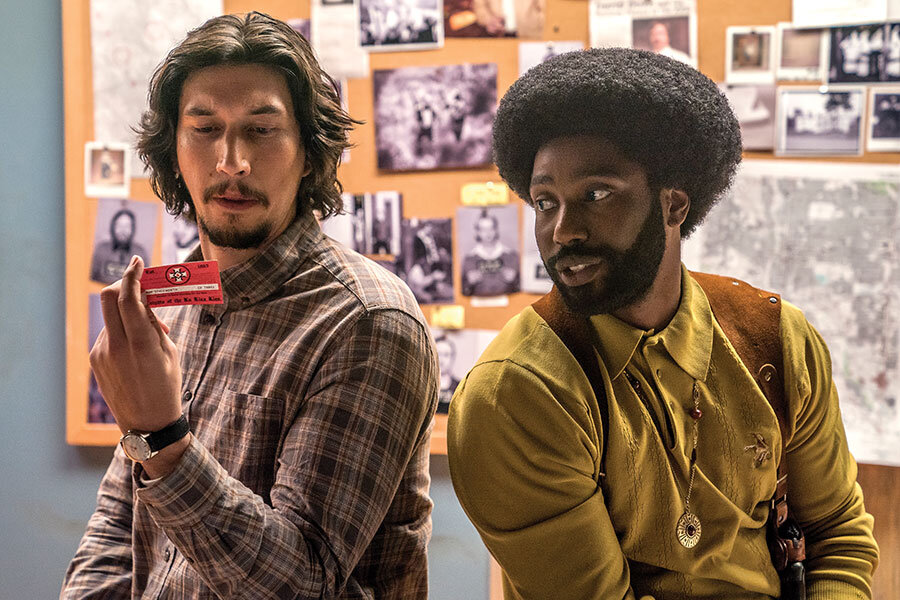'BlacKkKlansman' tells a truth-is-stranger-than-fiction story about the KKK
Loading...
Spike Lee’s “BlacKkKlansman” is based on a truth-is-stranger-than-fiction scenario. In the early 1970s, Ron Stallworth (John David Washington, Denzel’s son) becomes the first black police officer to join the Colorado Springs Police Department, which is openly recruiting minority applicants. His goal is to be a detective, and his first big assignment is to check out agitators by infiltrating a speech given at the black student union of a local college by activist Kwame Ture, aka Stokely Carmichael (Corey Hawkins). Subsequently, seemingly on a whim, he engages in an even more racially dissonant undercover operation. He calls up the local chapter of the Ku Klux Klan and spouts so much racist bile that the organization is eager to meet this potential recruit face-to-face.
Reluctantly at first, a fellow officer, Flip Zimmerman (Adam Driver), who is white and Jewish, agrees to impersonate Ron as he is rapidly and for the most part enthusiastically welcomed into the white-robed ranks. Ron keeps up the charade on the phone; Flip is his surrogate on the ground. Even the preternaturally slick Grand Wizard, David Duke (Topher Grace), is fooled.
Lee, who co-wrote this film with Charlie Wachtel, David Rabinowitz, and Kevin Willmott, based on Stallworth's memoir "Black Klansman," has regularly encouraged audiences and commentators to experience his movies as incendiary political acts. "BlacKkKlansman," which caused a stir at the Cannes Film Festival, opens with the long pull-back shot of Vivien Leigh’s Scarlett O’Hara in “Gone With the Wind” picking her way through the Confederate wounded and follows it with clips from D.W. Griffith’s monumentally racist 1915 classic “The Birth of a Nation,” the success of which revived the dormant Klan. He ends the movie with newsreel clips from the violent "alt-right" rallies last year in Charlottesville, Va.
This is a lot of heavy-duty baggage to load onto a movie that, in its deceptively lighter moments, plays out as a wiggy sketch comedy that would look right at home on "Saturday Night Live" (one can see the young Eddie Murphy in it) or as a "Key and Peele" episode. Jordan Peele, one of the film’s producers, was, in fact, going to direct the movie until the success of “Get Out” shifted the project to Lee.
Lee, however, is a very different filmmaker than Peele. Peele’s scathing wit is simultaneously blatant and creepily subtle. Lee makes his racial points with a bullhorn; he embraces agitprop. This may be why his documentaries, such as “When the Levees Broke” and “4 Little Girls,” in which he can dispense with actors and dialogue and use the historical record to channel his outrage, are superior to most of his dramatic films. In what is still his best movie, “Do the Right Thing,” Lee's anger came through, but he also created an interlocking cast of characters who functioned as living, breathing people and not, as so often has been the case, as mouthpieces to score political points.
This deficiency persists in “BlacKkKlansman,” in which too often the actors, who also include Laura Harrier as a black student activist and Ron’s sometimes girlfriend, go wooden whenever they are called upon to speechify. He even includes a sequence where Harry Belafonte speaks in excruciating detail of the 1916 Texas lynching of Jesse Washington, a black teen accused of the rape and murder of a white woman.
Lee’s overarching point, of course, underscored by the closing "alt-right" footage and clips of Donald Trump, is that we have not come very far at all from the early 1970s. His aesthetic in “BlacKkKlansman” is that, in making of movies that matter, we have moved beyond the niceties of normal dramatic strategies. Preachiness is a necessity. Subtlety is a sick joke.
Far greater artists than Lee have subscribed to this aesthetic, including Bertolt Brecht, Gillo Pontecorvo, and Jean-Luc Godard, but, if we are being asked to regard “BlacKkKlansman” as more than a movie, this may be another way of admitting that, on some fundamental level, it falls down as anything but revue sketch agitprop. Grade: B- (Rated R for language throughout, including racial epithets, and for disturbing/violent material and some sexual references.)







